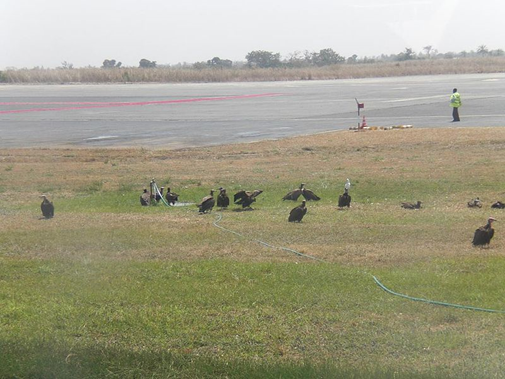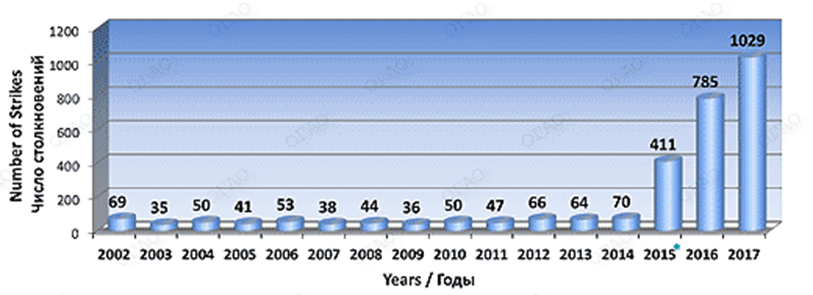 it
it  en
en
Archive 2019
One year ago we reported a "normal" ingestion of birds in a single engine, which occurred in Murcia on 27 March 2018 during the lining-up on the runway of an Easyjet A319, but official sources have now radically changed this version.
In fact, the Comisión de Investigación de Accidentes e Incidentes de Aviación Civil (CIAIAC) already in 2018 (news unfortunately passed unnoticed) had established that "the aircraft was accelerating for takeoff when both engines ingested birds causing high vibrations. The crew rejected takeoff below V1 and stopped on the runway. The aircraft sustained substantial damage limited to the engines "announcing the opening of a formal investigation.
After one year, CIAIAC announces that it has concluded the investigation but it cannot disseminate the findings as "it has been agreed that the publication and public dissemination of the Final Report be restricted." for unspecified reasons related to the Murcia airport military status and “the obligations of information to the parties in the civil field.”
It is indisputable, however, that this event constitutes the 11th case of double ingestion only in the last two years, 9 of which occurred to twin engine aircraft.
The Irish Post newspaper had initially published the incredible news of 54 ingestions of hares in taxiing aircraft engines at Dublin airport from January to November 2019. It had subsequently taken it down when it proved to be false. A spokesman for the Dublin Airport Authority (DAA) said some animals have been hit by taxiing planes and other vehicles, but none had been "ingested". “Contrary to media reports, no hares or birds have been ingested into aircraft engines Dublin Airport this year," said Paul O'Kane. "Unfortunately, 43 birds and 11 hares have been struck by either an aircraft or a vehicle on the airfield, but no animals have been ingested into an aircraft engine". Airport officials said they've taken measures to uphold high safety standards and prevent aviation risks. They've managed the nearby wildlife through a catch-and-release program and, when necessary, by shooting the animals, according to reports.
According to local media, the number of animal strikes so far this year has been cut almost in half from the 102 recorded in 2018.
Kites have been involved in the highest number of bird strike cases across civil and military airports, during take-off and landing across India, over the past 52 years, revealed data from the Indian Air Force (IAF) during the International Conference on Wetlands and Migratory Birds held in Lonavala.
Between 1966 and 2018, there would have been 1,041 "incidents" with birds involving 95 species. In most cases Black Kites (166) were involved, followed by the swifts (99), lapwing (98), vultures (85), bats (75) and pigeons (70).
The IAF data show that between 2010 and 2018, bird strikes caused by the Black Kites represented almost 16% of total accidents. The Black kites have been involved in three airline crashes including two fatal cases; 52 cases of damage and 33 accidents without damage. Bats (13% of total accidents) were involved in 32 cases of damage; the lapwings, 27; and the swift in 16 cases. The Indian Stone-Curlew has been involved in one accident.
These are the data provided during the conference as reported by The Hindustan Times website; which nevertheless cause concern because they clearly contrast with those provided by another Indian newspaper (The Hindu) which also contains official data (see the article below). According to the latter, only in the last three years there were 1,966 impacts. We should think that this is due to the use of improper terminology by the newspaper: the 1,041 cases should refer only to incidents and accidents, while the 1,966 to the total strikes reported in the last three years. However, of course, the doubt remains.
On 23 October 2019 a Rossiya A320 aircraft rejected take-off at St. Petersburg airport following the ingestion of birds in the right-hand engine. A few days later the Russian Aviation Authority Rosaviatsia issued some recommendations substantially stating that the incident was due to the “inefficiency of ornithological support for flights”.
The recommendations can be summarized as follows:
- The airport must implement an ecological and ornithological research referred to the airport environment and consider the modernization of equipment (and software programs) to scare birds, based on the research conducted.
- The airport must increase the staff of the bird control units to improve safety.
- The airport must modify its instructions regarding the “ornithological guarantee” for flights as concerns the procedures for controlling the correctness and timeliness of the actions by the responsible persons, as well as producing the necessary documentation and drawing up an event database that must be noted and studied in accordance with the regulations in force.
- Rossiya Airlines and the airport management must analyse the materials related to this incident in the context of their flight safety management systems and must draw up a report on the fulfillment of the recommendations by 16.12.2019.
Normally this website does not deal with incidents and/or accidents concerning military aircraft due to the impact with birds. The exception regards the loss of an Indian Navy Mig 29KUB which fortunately ended up without victims. In fact, the event occurred near the Goa airport, that, being a base of the Indian Navy, is also open to civil air traffic, with over 7 million passengers transported per year. Last quarter we reported two worrying events due to the presence of stray dogs on the runway of that airport; this time it’s birds that have invaded the approach and take-off paths because of the presence of household waste being dumped indiscriminately all along the roads and highways in the underlying lands. In this case the fighter has ingested birds in both engines. Someone has rightly pointed out that while a military pilot can eject, hundreds of passengers cannot, not to mention those who reside nearby.
Damage from foreign objects like bird strikes is nothing new in aviation, but we are seeing a high level of foreign object damage claims with more than 14,600 reported collisions with wildlife in 2018, according to Federal Aviation Administration (FAA) data. It corresponds to an average of 40 bird strikes per day in the U.S.
According to Allianz analysis of more than 50,000 aviation insurance claims, bird strikes are a notable contributor to aviation collision/crash incidents, resulting in excess of €330 million ($364M) of insured damages between July 2013 and the end of 2018 — over 1,000 (1,032) related claims were received by insurers during this period in this data set. The average bird strike claim costs € 327,232 ($ 361,356), with some claims costing as much as €15 million ($16.6M) and up. Most accidents occur when birds hit windscreens or fly into engines.
Estimates of the economic toll of bird strikes have been calculated at as much as $400 million a year in the U.S. to $1.2 billion worldwide, although conclusive numbers are hard to come by especially due to the reticence of air carriers and sometimes of some States.
The estimate of the average value of bird strike related damage in the US can be a valid aid for assessing the economic weight of bird strikes also in Italy, where approximate calculations so far bring this value to € 7,5 million per year, including however indirect costs (delays, assistance and rerouting of passengers, etc.) normally not refundable.
The FAAN (Federal Airport Authority of Nigeria) completed a six-month bird removal project along the runway extension of the parallel runways of Lagos airport. The removal of about 5000 birds was carried out by the local Bird Hazard Control that decided to naturally dislodge them by changing the environmental characteristics of the habitats, thereby making the birds relocate voluntarily. Now hopefully the FAAN management will quickly consider replicating this project across the nation’s airport facilities.
Nigeria is therefore becoming aware of the risk associated with the presence of birds in its airports, urged also by the local press, which often critically represents the state of things. In fact, the article below also reports some data on bird strikes, which appear to us to be somewhat underestimated, but which are nevertheless a clear sign of attention to the phenomenon.
The Director General of the Gambia Tourism Board, Abdoulie Hydara, during a press conference following the arrival of Corendon Airlines' maiden flight from Amsterdam, assured that no stone will be left unturned to solve the problem of bird strikes at Banjul airport. Mr. Hydara emphasized on the importance authorities attach to the issue of bird strikes and revealed that giant strides were already made by working with all the municipalities, the relevant ministries, and the various parties that have responsibility for managing this problem. He went on adding that many improvements were already made in the airport and its surroundings, as they are fully aware of the dangers of bird strikes, which "could be even worse than the collapse of Thomas Cook" for the Gambian economy.
The measures to which Mr. Hydara refers are a campaign that will involve the killing of birds that pose danger to airplanes, the trimming of trees around the airport premises and the cleaning and disposal of wastes from both dumpsites and households around the periphery of the airport.
The presence of flocks of birds has been a big problem during the last winter tourist season. The birds in fact frequently visited a landfill near the airport in search of food causing delays to numerous flights.
Below are the most significant events that occurred in Banjul in recent years:
- 26.04.2019: Titan Airways A320, after take-off a vulture collided with the aircraft causing damage to the first officer's windscreen. The crew burned off fuel and landed back about 100 minutes after departure.
- 16.02.2018: Brussels Airlines A330, after landing in Banjul a post flight inspection revealed the aircraft had received a bird strike during the flight and was unable to continue schedule; the flight was postponed by 49 hours and operated by another aircraft;
- 8.11.2016: Thomas Cook A321, flew through a large flock of storks at rotation (V1) and ingested a number of birds into both engines while other birds struck the aircraft in several points; after take-off the right engine began to vibrate significantly and had to be shut down; the aircraft came to landing 45’ later; a post flight inspection revealed a bird hanging from the right main gear; 13 dead birds found on the runway;
(Vultures at Banjul airport; photo taken from Wikipedia)
An interesting article published in the online newspaper "The Hindu" shows the number of bird strikes recorded in India in the years 2015, 2016 and 2017.
According to the article, which reports official data, in 2015 there would have been 764 impacts with 66 damaged aircraft.
In 2016 the impacts are reported to be 839 with 103 damages and in the first half of 2017 alone there would have been 363 events with 72 damaged aircraft.
As it is evident to the reader, only an infinitesimal part of these events had a media resonance.
Also in this case, likewise for the Russian situation discussed last quarter, the number of impacts appears to be underestimated, given that approximately a thousand events are reported annually in Italy, whose air traffic is much lower than the Indian, as well as the number of airports.
The situation would also be worrying for the IAF (Indian Air Force) which would be preparing for the fourth purchase in ten years of avian radars for the remote detection of birds. According to one estimate, bird strikes are the cause of around 10% of fighter jet accidents.
Another article reports the data of the impacts for the current year in Pakistan. According to a spokesman for Pakistan International Airlines, 59 impacts have been reported so far in 2019, 18 of which would be considered serious inconveniences. Ten would have happened only in Lahore airport.
- 1 October – Milan (Malpensa)
ASL Airlines France B737, bird strike during the initial climb; the crew decided to land back immediately, 20’ after take-off; - 2 October – Santa Fe (NM)
Skywest CRJ700, bird strike on landing; minor damage; - 4 October – Louisville (KY)
Southwest B737, on approach flew through a flock of small birds and suffered multiple impacts; minor damage; - 4 October – Alicante
Easyjet A319, during the initial climb an engine ingested a number of birds prompting the crew to stop the climb and land back about 40 minutes after departure.
https://www.belfastlive.co.uk/news/belfast-news/easyjet-flight-alicante-belfast-forced-17037547 - 5 October – Karachi
Gulf Air A320, rejected take-off at low speed further to a bird strike; - 9 October – San Francisco (CA)
United B737, bird strike right on rotation, the crew decided to continue the climb but later declared emergency advising they were now getting a vibration. The crew landed back, after having burnt off fuel, about 35 minutes after departure. - 9 October – Tijuana (Messico)
Volaris A320, while on approach the aircraft flew through a flock of birds and received a bird strike. A bird remained embedded in the landing gear.
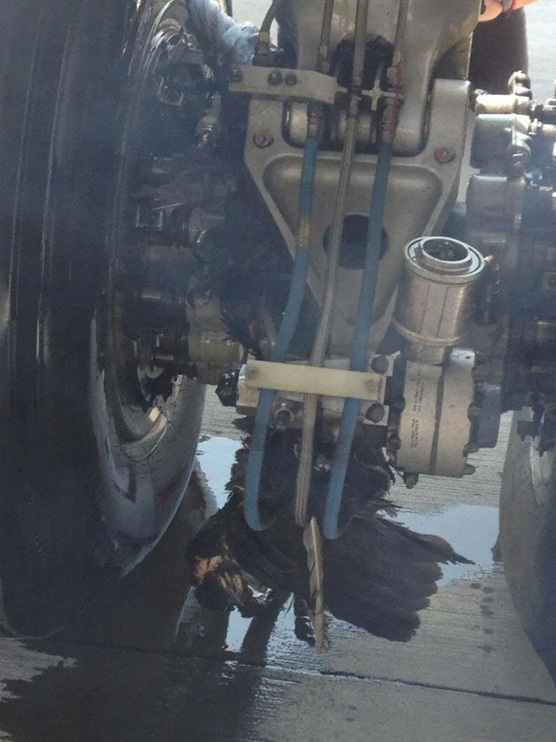
(The bird embedded in the landing gear; photo taken from Avherald.com) - 13 October – Dalaman (Turchia)
Jet2.com B757, on approach a bird impacted the nose cone of the aircraft causing a dent . The aircraft was able to depart for the return flight.
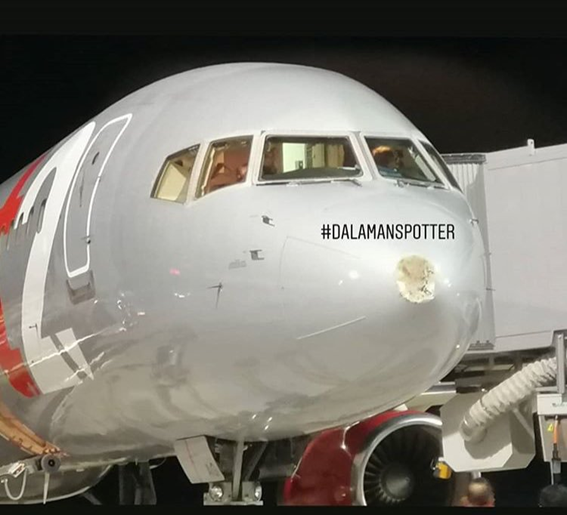
(Photo Dalamanspotter taken from Newsinflight.com) - 14 October – Dacca (Bangladesh)
Biman B737, bird strike during the initial climb; the crew decided to return about 25’ after trake-off;
https://tbsnews.net/economy/aviation/biman-flight-makes-emergency-landing-dhaka-airport - 15 October – New York (La Guardia)
American B737, on approach flew through a flock of birds, reportedly geese, and received a number of hits; - 16 October – Santiago (Dominican Rep.)
Jetblue A320, on approach received a bird strike; minor damage; - 19 October – Bremen
Eurowings Europe A320, during rotation an engine ingested a number of birds. The crew continued the climb then shut the engine down due to severe vibrations. The crew then requested to divert to Hanover where landed 45 minutes after departure.
https://simpleflying.com/eurowings-airbus-a320-birdstrike/ - 21 October – Atlanta (GA)
Endeavor Air CRJ200, bird strike during approach; substantial damage; - 23 October – St. Petersburg
Rossiya A320, rejected take off at high speed further to the ingestion of a bird into the right engine; - 27 October – Durban Safair B737
during the initial climb the right engine ingested a bird causing the engine to vibrate; the crew decided to return and landed back 25 after departure; - 28 October – Copenhagen
SAS A330, during the initial climb the aircraft reportedly flew through a flock of geese. In the absence of abnormal indications the crew continued the climb. When en route the crew decided to turn around and return. The aircraft landed back about one hour after the decisition to turn around. - 30 October – Johannesburg
South African A319, a post flight inspection revealed a bird had struck the underside of the nose radome causing damage to the radome;
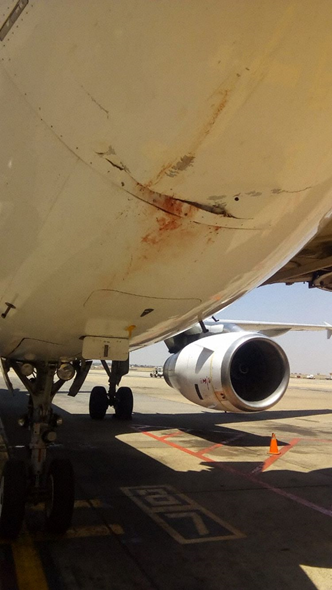
(Photo taken from Avherald.com)
- 1 November – Tyumen (Russia)
Yamal Sukhoi SU95, during the initial climb the left hand engine ingested a bird prompting the crew to burn off fuel and land back about 75 minutes after departure.
https://tass.com/emergencies/1086615 - 2 November – Salt Lake City (UT)
Skywest CRJ200, bird strike during the final approach; minor damage; - 2 November – Bilbao
White ATR72, rejected takeoff at high speed (about 125 knots over ground) due to an eagle colliding with the aircraft and a propeller. - 5 November – Houston (TX)
Delta MD90, during the initial climb the crew reported they had hit a flock of birds with impacts at the cockpit, and there was possibly a leak at the right-hand side. The aircraft returned for an approach but went around on short final due to the nose gear indicating unsafe. The crew advised they would keep their gear down while positioning for another approach and landed safely.
https://simpleflying.com/delta-md-90-houston-birdstrike/ - 6 November – Porto
Ryanair B737, in the initial climb the crew reported a bird strike into one of the engines and decided to land back 30’ after departure; ATC reported a number of small birds were recovered from the runway. - 8 November – Vancouver
United A319, the crew rejected take-off at high speed reporting a bird strike on the nose and later specifying it was a rather large bird, a crane or something like that.
https://vancouversun.com/news/local-news/flight-bound-for-denver-aborts-takeoff-at-yvr-due-to-possible-bird-strike - 7 November – Kansas City (MO)
UPS MD11, was climbing through about 8000 feet when the crew reported they had flown through a large flock of geese, all engines were still running though with vibrations, they wanted to return immediately. After landing the crew advised they saw at least a dozen geese, the #1 engine was worst affected. - 13 November – Detroit (MI)
Endeavor CRJ900, on approach the aircraft received a bird strike; - 14 November – Green Bay (WI)
Frontier A320, a post flight inspection revealed the aircraft had sustained a bird strike to an engine disabling it to depart for the inaugural flight to Orlando.
https://www.travelpulse.com/news/airlines/frontier-airlines-inaugural-flight-celebration-ruined-by-bird-strike.html - 19 November – Sacramento (CA)
Skywest ERJ175, during the initial climb suffered a bird strike; immediate return 15’ after take.off; - 19 November – San Diego (CA)
Westjet B737, on approach the aircraft flew through a flock of birds and received a number of bird strikes. A post flight inspection revealed damage to the aircraft disabling it to carry out the return flight. - 25 November – West Palm Beach (FL)
Jetblue A320, bird strike during the final approach; - 1 December – Boston (MA)
American Airlines ERJ190, during the initial climb hit a flock of geese; immediate return 11’ after take off;
https://stockdailydish.com/american-airlines-flight-makes-emergency-landing-after-hitting-flock-of-geese/ - 2 December – Matsuyama (Japan)
JAL B737, at take-off the left hand engine ingested a bird. The crew initially continued the climb, but later reported abnormal engine indications and diverted to Osaka 50 minutes after departure. - 5 December – Quetta (Pakistan)
PIA A320, on approach flew through a swarm of locusts that left remarkable signs on the nose and the windscreen;
https://thefinancialdaily.com/swarm-of-locusts-storm-pia-pre-landing-plane/
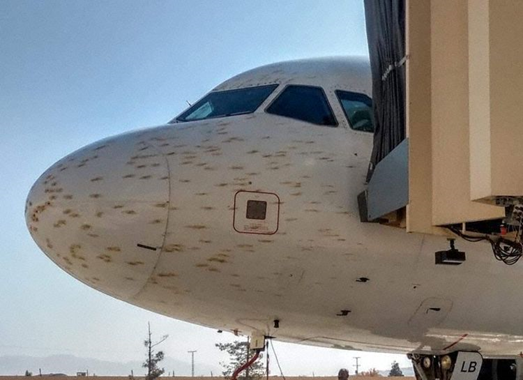
(Photo M. Salahuddin taken from Avherald.com) - 8 December – Seattle
Frontier A321, bird strike on approach; the aircraft was unable to continue its schedule. - 10 December – Peshawar (Pakistan)
Serene Air B737, on approach a bird impacted the right-hand engine's inlet. The aircraft was unable to continue its schedule.
https://dunyanews.tv/en/Pakistan/522616-Private-airline-escapes-fatal-accident-Peshawar - 11 December – Karachi
PIA A320, during the initial climb the right engine ingested a bird causing several fan blades dented; immedate return 25’ after departure; a PIA spokesperson said that damage was likely to cause a huge financial loss worth $5 million to the national flag-carrier.
https://dailytimes.com.pk/518352/newly-inducted-pia-plane-escapes-mishap-following-bird-hit-in-karachi/ - 12 December – Karachi
PIA A320, on approach a bird impacted the right hand wing and embedded itself in the slats.
https://www.samaa.tv/news/2019/12/pia-plane-grounded-after-hitting-bird/
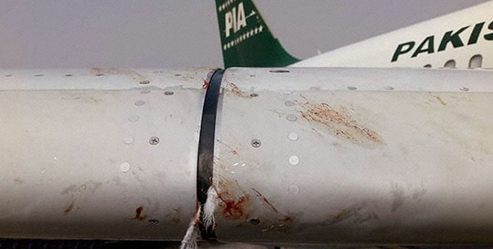
(Photo taken from Avherald.com) - 15 December – Delhi
Air India B787, bird strike in the initial climb; the crew decided to dump fuel and land back; maintenance replaced a damaged part of the aircraft and flight delayed by 4 hours; - 19 December – Fortaleza
Azul Linhas Aereas A330, multiple bird strikes during the initial climb; immediate return 15’ after departure; - 20 December – Ukunda (Kenia)
Jambojet Dash 8, bird strike during the approach; the crew went around and decided to divert to Mombasa;
https://hivisasa.com/posts/11552398-kenyan-plane-forced-to-make-an-emergency-landing-after-being-hit-by-birds - 21 December – Pune (India)
GoAir A320, during the initial climb suffered a bird strike and landed back 20’ after departure; - 24 December – Lincoln (NE)
Skywest ERJ175, on short final a number of geese collided with the aircraft; minor damage reported but the aircraft had to be taken out of service; - 25 December – (supposedly) Madrid
Iberia A320, a post flight inspection at Milan Linate airport revealed a dent in and blood on the radome;
https://simpleflying.com/iberia-airbus-a320neo-birdstrike/
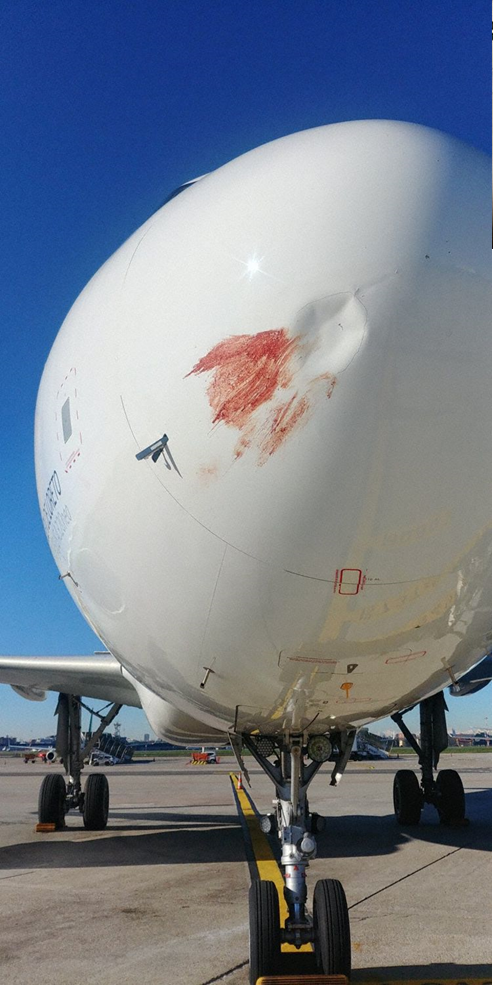
(Photo Andrei Sam taken from Avherald.com) - 28 December – Austin (TX)
Delta A319, during the initial climb suffered an impact with something that might have been a bird or a drone; immediate return 15’ after departure;
https://edition.cnn.com/2019/12/28/us/delta-flight-returns-to-austin/index.html - 29 December – Portland (OR)
Horizon Air ERJ175, bird strike on landing; - 29 December– Thiruvananthapuram (India)
Scoot A320, after take off the right engine ingested a bird that caused severe vibrations and prompted the crew to land back;
https://stomp.straitstimes.com/singapore-seen/scoot-flight-from-india-to-singapore-delayed-after-bird-strikes-aircrafts-engine
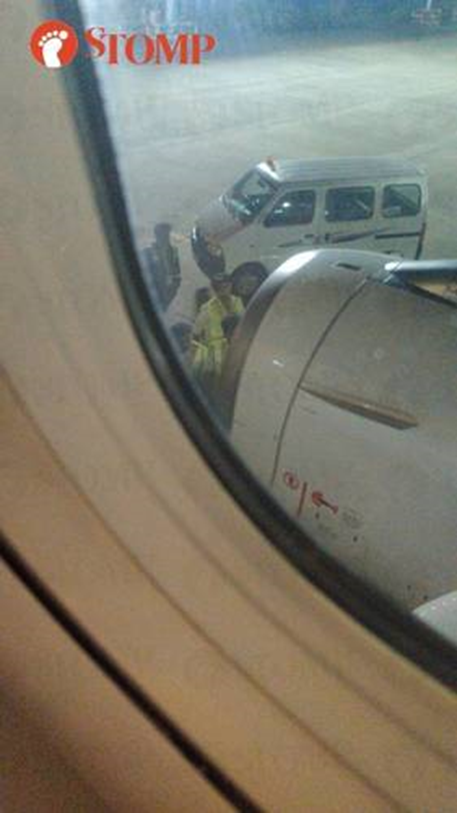
(Maintenance controls the engine after birdstrike; Photo taken from https://stomp.straitstimes.com/)
Indeed a difficult August for the Russian airline! It started on August 8 with a bird strike on landing at Moscow Zhukovsky airport. It continued on August 15 with one of the most serious accidents in history, which has not turned into a tragedy only due to the concurrence of fortunate circumstances. We are talking about an A321 off-field landing, with 233 people on board, following an ingestion of gulls in both engines. And it ended on August 30th in St. Petersburg with a multiple impact that later forced the crew to divert to Yekaterinburg. Two of these events occurred at Moscow Zhukovsky airport, which we will be the topic of further comments immediately below.
August 15 will probably be included among the dates when the pilots' skill and luck have avoided a catastrophe. The UralAir U6-178 flight to Simferopol suffered the ingestion of a number of gulls into both engines immediately after take-off and the crew was forced to make an emergency landing in a cornfield at 4.5 km. from the airport. During the evacuation some passengers were injured but no fatal consequences are recorded. Zhukovsky airport, or Ramenskoye as it appears in the Russian AIP, is the Moscow's fourth airport. The AIP does not report any warning about the presence of birds nor indicates procedures for their removal from the airfield (see
The species of gulls involved in the accident appears to be the European Herring Gull (Larus argentatus). The airport is located near the Moskva River which may be an attraction for such birds.
This is the ninth case of dual ingestions in the last two years and the relative frequency of these events should convince the regulators to change the engine certification requirements in a more restrictive sense. In fact, dual ingestions and the relative engine power loss, besides the direct effects on the flight, are often associated to other causal factors and can lead to high-risk and potentially catastrophic events.
The table below (source: http://www.otpugivanie.narod.ru/eng.html), with an unreasonably low number of impacts until 2014 and a remarkable increase in subsequent years, shows that Russia now seems to be aware of the hazard and is going to increase the reporting action. However, the figures still appear too low compared to the real numbers of impacts (a thousand impacts a year is in fact the Italian figure, whose network of airports and flights is far less than the Russian). In part the phenomenon can be explained as the reporting of impacts in Russia is still substantially on a voluntary basis.
Unfortunately the news of animals on the airport runways is showing an increase (see 13, 16 August and 1 September). If in the second case the event can be understood (but not justified) as it involves a dirt strip inside a reserve in the African savannah, the first and the third cause concern. In fact, the civil airport of Goa is an enclave within a military structure, where controls are supposed to be rigorous, and it handles over 7 million passengers each year. The presence of stray dogs is essentially a matter of inefficiency of the airport fence, but the established habit of keeping animals as mascots should not be underestimated, if not a question of religious beliefs. Goa airport has also announced mitigation measures including the capture and relocation elsewhere of the incredible number of about 200 dogs around the runways.
The reports of two investigations conducted in the United States regarding two incidents that occurred respectively on 11/24/2013 in Philadelphia and 27.03.2019 in Nashville, are now available.
In addition, we acquired two new sentences released further to trials for damage compensation following impacts with wildlife in Australia and South Africa. Although these events involved general aviation aircraft, we believe that the position of the Courts in this matter is always relevant.
- 4 July – Enroute between New York and Ft.Lauderdale
Jet Blue A321, a post flight inspection revealed that an engine had ingested a bird. The aircraft was thus unable to depart for the return flight; - 8 July – Copenhagen
Lufthansa A320, received a bird strike on landing; return flight cancelled; - 8 July – Dusseldorf
Eurowings A330, during the initial climb an engine ingested a bird. The crew continued the climb at first, then stopped the climb at FL200 and decided to return to Dusseldorf. The aircraft burned off fuel and landed back about 2 hours after departure. - 11 July – Paris (CDG)
Singapore Airlines A380, on approach to CDG the aircraft flew though a flock of birds and received a number of impacts on nose and leading edge of the right hand wing's root;
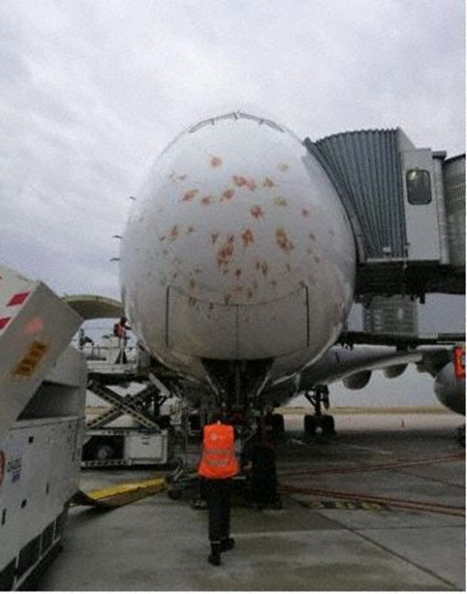
(Photo: Donald Liew taken from Avherald.com) - 13 July – Broome (Australia)
VARA F100, during the initial climb the aircraft received a bird strike. The crew stopped the climb at 5000 feet, burned off fuel and landed back about 80 minutes after departure. - 14 July – Dusseldorf
Eurowings A330, during the initial climb an engine ingested a bird; the crew levelled off at FL100 and entered a hold to burn off fuel, then landed back about 50 minutes after departure; - 14 July – Puerto Vallarta (Mexico)
Magnicharters B737, during the initial climb the right hand engine ingested a bird and emitted a number of bangs. The crew shut the engine down and landed back.
https://www.youtube.com/watch?v=E3c12sL3xck - 16 July – Manila
Cebu Pacific A320, during the initial climb an engine ingested a bird; the crew landed back 20’ after take off;
https://news.mb.com.ph/2019/07/16/cebu-pacific-aborts-flight-due-to-bird-strike/ - 17 July – Traverse City (MI)
Air Cargo Carriers SH36, multiple bird strike during the approach; minor damage; - 19 July - Cardiff
Flybe ERJ175, bird strike during the initial climb; immediate return; - 19 July – Concord (NC)
Allegiant A319, bird strike on approach; - 20 July – Dublin
Aer Lingus B757, during the take-off run the right engine ingested a bird; the crew decided to return and landed back 27’ after take off; flight and next leg cancelled; - 22 July – Cincinnati (OH)
Frontier A320, bird strike on approach; - 24 July – Rio de Janeiro (S.Dumont)
Azul ERJ190, multiple bird strike during the initial climb; the crew decided to divert to Galeao airport 20’ after take-off; - 25 July – Geneva
Swiss Bombardier CS-300, during the initial climb the left engine ingested a bird that caused bangs and streaks of flame; the crew decided to divert to Paris; - 25 July – Faro
Easyjet A319, during the initial climb an engine ingested a bird; immediate return 20’ after take-off; - 26 July – Berlin
during the initial climb the left engine ingested a bird that caused bangs and streaks of flame; immediate return 18’ after take-off; - 27 July – Erie (PA)
Air Wisconsin CRJ200, bird strike on final; minor damage; - 29 July – Kiev
Ukraine International Airlines B767, during the initial climb an engine ingested a bird; immediate return 20’ after take off;
http://www.xinhuanet.com/english/2019-07/30/c_138270232.htm - 30 July – between Dallas (TX) e New Orleans (LA)
American A321, at the gate a dent at the leading edge of the right hand wing as result of a bird strike was discovered;

(The dent seen at the gate; photo taken from Avherald.com) - 30 July – Istanbul
THY B777, on approach the aircraft flew through a flock of birds and received multiple bird impacts on the left-hand side. A post flight inspection revealed multiple bird impacts to the leading edge of the left hand wing from wing root to wing tip, the position light at the wing tip was damaged, one bird had penetrated the underside of the left wing. The aircraft was unable to perform its next flight. https://ahvalnews.com/istanbul-airport/turkish-airlines-plane-damaged-after-colliding-birds-istanbul-airport - 6 August – Porto
United B757, during the initial climb an engine ingested a bird and failed; immediate return 280 after take-off; flight cancelled; - 7 August – Liverpool
Ryanair B737, during the initial climb a bird impacted the aircraft prompting the crew to burn off fuel and land back about 40 minutes after departure. - 8 August – Moscow (Zhukovsky)
Ural Airlines A321, bird strike on landing; birds hit the left engine inlet;
https://www.flightglobal.com/news/articles/second-ural-a321-hit-by-birds-a-week-before-field-la-460370/ - 9 August – Columbus (OH)
American B737, during the initial climb the aircraft flew through of flock of geese and received a number of bird strikes. The crew decide to return and landed about 20 minutes after departure. - 10 August – Rzeszow (Polonia)
LOT ERJ195, was accelerating for takeoff fwhen the crew rejected takeoff at low speed due to a bird strike. The flight was cancelled. - 11 August – Lajes
Azores Airlines A320, bird strike on approach; the aircraft was unable to depart for the return flight and th enext flights that have been cancelled; - 13 August – Calgary
Westjet B737, bird strike at take-off; the crew decided for an immediate return;
https://globalnews.ca/news/5760572/westjet-flight-toronto-calgary-bird-strike/ - 13 August – Goa (India)
Air India A320, went around on final due to the presence of stray dogs on the runway; - 15 August – Moscow (Zhukovsky)
Ural Airlines A321, during the initial climb at about 750 ft. flew through a flock of gulls a number of which were ingested in both engines causing their failure; the crew managed to make an emergency landing in a corn field nearby with gear retracted; 74 persons injured;
https://www.reuters.com/article/us-russia-airplane-accident/russian-plane-makes-emergency-landing-near-moscow-after-bird-strike-idUSKCN1V50E7 - 16 August – Maasai Mara (Kenia)
Safarilink Dash 8, during the landing roll collided with a number of gnus (also known as Wildebeests - (Connochaetes gnou) causing the left main gear to collapse and separate from the aircraft, the left propeller impacted ground ejecting one blade, and the aircraft veered left off the runway. There were no injuries, the aircraft sustained substantial damage.
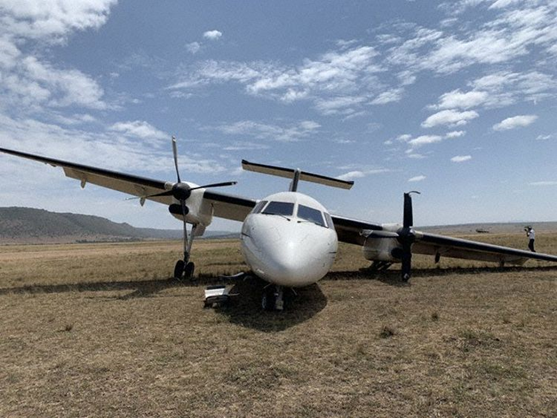
(Photo: Eric Stern MD, taken from Avherald.com) - 16 August, Moscow (Vnukovo)
UTAir B737, during the initial climb suffered a multiple bird strike: a bird was ingested into one engine and another hit the windscreen; the crew decided to land back 15’ after take-off; - http://vestnikkavkaza.net/news/Bird-strike-causes-Utair-flight-to-return-to-Vnukovo-airport.html
- 26 August – Lahore
PIA B777, on final approach the left-hand engine ingested a bird;
https://tribune.com.pk/story/2042617/1-lahore-bound-flight-suffers-bird-strike-lands-safely/ - 26 August – Muscat
Salamair A320, on approach the aircraft sustained a bird strike; the aircraft was unable to depart for the return flight; - 30 August – St. Petersburg
Ural Airlines A321, during take-off flew through a flock of birds; the crew initially decided to continue but later diverted to Yekaterinburg;
https://www.eturbonews.com/264909/russian-ural-airlines-another-emergency-landing-after-another-bird-strike/ - 30 August – Bremen
Turkish Airlines B737, during the initial climb the aircraft hit a bird; the crew decided to land back 35’ after take-off; - 1 September – Goa (India)
Air Asia India A320, following TWR instructions rejected take-off due to the presence of a stray dog on the runway; - 1 September – New York (JFK)
Delta A330, bird strike during the approach; - 1 September – Stockholm
SAS A320, bird strike during the approach; - 2 September – Saint Louis (MO)
American Airlines A319 during the initial climb a bird hit an engine causing two engine blades broken; the crew decided to land back 15’ after take-off; - 4 September – Ranchi (India)
Indigo A320, rejected take-off due to a bird strike;
the crew decided to land back 15’ after take-off;
https://www.hindustantimes.com/india-news/delhi-bound-indigo-flight-suffers-bird-hit-in-ranchi-passengers-safe/story-qdTpvWWyfHLnFmKbutLWiK.html - 4 September – Nanjing (Cina)
Sichuan Airlines A319, during the initial climb the aircraft hit a bird; the crew decided to land back 50’ after take-off; - 6 September – Perth
Qantas A330, during the initial climb the aircraft struck an eagle at 4000 ft.; the crew decided to land back 18’ after take-off;
https://www.perthnow.com.au/news/wa/perth-to-melbourne-qantas-flight-turns-around-after-hitting-eagle-after-take-off-ng-b881315792z - 7 September – Cardiff
Flybe ERJ175, rejected take-off due to a bird ingestion into one engine;
https://www.walesonline.co.uk/news/wales-news/plane-evacuated-cardiff-airport-after-16881747 - 10 September – Abbortsford (Canada)
Swoop Airlines B737, during the initial climb the right engine ingested a number of geese causing the engine to emit bangs and streaks of flames; immediate return about 20 minutes after departure.
https://www.citynews1130.com/2019/09/10/witnesses-boom-plane-takeoff-abbotsford/ - 10 September – Mosca (Sheremetyevo)
Aeroflot B737, during the approach a young gull struck the nose gear and got entangled;
https://www.youtube.com/watch?time_continue=22&v=3m1eEG0HEWo - 10 September – Ahmedabad
GoAir A320, during the initial climb the aircraft hit a bird; the crew decided to land back 20’ after take-off; - 13 September – Los Angeles (CA)
Norwegian Long Haul B787,on approach the aircraft received a bird strike but continued for a safe landing; the aircraft however was unable to perform the next scheduled flight that was cancelled. - 15 September – Shangai (Pudong)
China Eastern A330, during the initial climb the aircraft hit a bird; the crew decided to land back 15’ after take-off;
https://www.thatsmags.com/shanghai/post/29443/flight-from-shanghai-to-brisbane-forced-to-turn-back-after-bird-strike - 15 September - Tiruchirappalli (India)
Sri Lankan Airlines A320, during the approach the right engine ingested a bird;
https://timesofindia.indiatimes.com/city/trichy/srilankan-airlines-plane-suffers-bird-hit-while-approaching-trichy-airport/articleshow/71151853.cms - 16 September – Jaipur (India)
GoAir A320, rejected take off at high speed further to the ingestion of a bird into the left engine; - 16 September – Istanbul (Ataturk)
THY A330, during the initial climb a bird impacted the aircraft. The crew continued the climb in the absence of any adverse effects and was enroute at FL300 when a windshield cracked. The crew then decided to return for landing 2:50 hours after departure. - 17 September – Perth
Qantas B737, during the initial climb the aircraft hit a bird; the crew decided to land back 40’ after take-off; https://thewest.com.au/news/aviation/melbourne-bound-qantas-flight-strikes-four-birds-forcing-return-to-perth-ng-b881326591z - 21 September – London (Southend)
Air Malta A320, rejected take off at high speed further to the ingestion of a bird into the left engine;
https://timesofmalta.com/articles/view/air-malta-flight-from-loundon-delayed-due-to-birdstrike.736775 - 24 September – West Palm Beach (FL)
Jetblue A320, struck a bird while on approach; a post flight inspection revealed a hole in the radome; - 27 September – Malta
Air Malta A320, rejected takeoff at high speed due to an ingestion of a pigeon into an engine; flight cancelled and considerable damage to the engine; technicians said that out of 36 titanium fan blades, 24 were permanently damaged.
https://www.maltatoday.com.mt/news/national/97696/bird_strike_grounds_air_malta_plane_all_
passengers_are_safe#.XZHVqkYzbIU
(Air Malta engineer holding one of the titanium blades damaged by the bird strike.

(Photo James Bianchi/MediaToday) - 29 September – Belfast (City Airport)
Aer Lingus A320, during the initial climb flew through a flock of birds and received several impacts; the crew decided to turn back and land at Belfast International; flight cancelled as well as the return leg;
https://www.belfasttelegraph.co.uk/news/northern-ireland/belfast-to-london-flight-forced-to-turn-back-after-colliding-with-birds-38544587.html - 29 September – Phoenix (AZ)
American A319, bird strike on short final (100 ft.);
- 2 April – Moscow (Domodedovo)
S7 Airlines A319, rejected take-off at high speed (90 kts.) due to the presence of a flock of birds ahead; - 7 April – Miami (FL)
American Airlines B737, during the initial climb received a bird strike that prompted the crew to land back 15’ after take-off; - 11 April – Seoul (Gimpo)
Korean Air B737, after take-off an engine ingested a bird that caused bangs, flames and vibrations and prompted the crew to land back 35’ after take-off;
https://www.upi.com/Top_News/World-News/2019/04/11/Korean-Air-flight-makes-emergency-landing-after-bird-strike/2431554999863/ - 13 April – Zurich
Swiss A320, during the initial climb the right engine ingested a bird and showed vibrations; the crew decided to burn off fuel for 45’ and then returned to land 65’ after take-off; - 15 April – Lyon
Air Malta A320, bird strike during the approach; return flight delayed; - 15 April – Greensboro (NC)
American Airlines (ERJ175), during the initial climb flew through a flock of birds and landed back;
https://www.aviationpros.com/aoa/wildlife-management/news/21076560/plane-flying-out-of-piedmonttriad-international-airport-strikes-birds-damaged-plane-returns-to-airport - 18 April – Kathmandu (Nepal)
Nepal Airlines A320, bird strike during the landing roll; - https://www.aviationnepal.com/nac-witness-another-bird-strike-no-casualties/
- 18 April – Seattle (WA)
Alaska Airlines A320, bird strike at take-off; immediate return;
https://www.kiro7.com/news/local/alaska-airlines-flight-returns-to-sea-tac-after-bird-strike/941660860 - 19 April – Bismarck (ND)
Sun Country Airlines B737, on landing struck a bald eagle that caused damage to the right wing; the aircraft could not fly the next leg;
https://www.kfyrtv.com/content/news/Birdstrike-grounds-Sun-Country-plane-at-Bismarck-Airport-508983511.html - 22 April – Seoul (Incheon)
Thai B777, bird strike on departure. The aircraft returned and safely landed back after 27 minutes.
https://morning-news.bectero.com/social-crime/23-Apr-2019/142515 - 24 April – Ljubljana
Adria Airways CRJ900, rejected take-off at high speed due to a bird strike; - 26 April - Riga
Aeroflot SU95, after take-off a bird strike prompted the crew to land back;
https://www.urdupoint.com/en/world/moscow-bound-aeroflot-plane-returned-to-riga-606894.html - 26 April – Bulawayo (Zimbabwe)
Air Zimbabwe B767, after take-off hit several birds and a number of them was ingested into the left engine; in the absence of abnormal indications, the crew decided to continue to destination (Harare).
https://bulawayo24.com/index-id-news-sc-national-byo-161358.html - 26 April – Portland (OR)
Southwest B737, a post flight inspection revealed that a bird strike had caused a dent on a wing; the aircraft was unable to continue its service. - 26 April – Hattiesburg (MS)
Skywest CRJ200, was accelerating for take-off when the aircraft struck a deer and rejected take-off; - 26 April – Banjul (Gambia)
Titan Airways A320, after take-off a vulture collided with the aircraft causing damage to the first officer's windscreen. The crew burned off fuel and landed back about 100 minutes after departure. - 28 April – Bucarest
British Airways A321, suffered a bird strike on approach that caused a dent on the nose; the return flight was been delayed by 6 hours. - 1 May – Bucarest
Wizzair A321, during the initial climb hit a pigeon that caused damage to the weather radar; landed back 40’ after departure; - 2 May – Amsterdam
KLM Cityhopper ERJ190, after take-off the crew requested to stop the climb reporting they had a bird strike on their nose and wanted to consult with dispatch whether to continue or return. Despite nothing was found on the runway, the crew landed back about 20 minutes after departure. - 3 May – London (Heathrow)
Virgin Atlantic B787, during the initial climb a bird impacted the nose of the aircraft. The crew landed back about one hour after departure. The aircraft was unable to fly and was replaced.
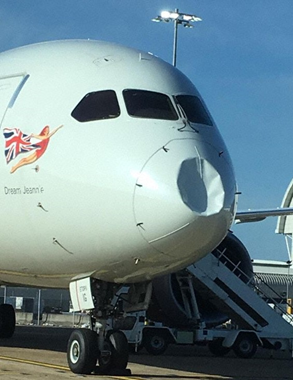
(The damaged nose; photo taken from Avherald.com) - 5 May – Multan (Pakistan)
Gulf Air A320, bird strike at take-off; immediate return and flight delayed for controls;
https://www.pakistantoday.com.pk/2019/05/05/plane-makes-emergency-landing-after-bird-hit/ - 6 May – Oackland (CA)
Southwest B737, on final approach the crew reported a flock of birds at about 1000 feet AGL and suffered a bird strike. After landing the aircraft was vacating the runway but the crew reported they lost their nose wheel steering and needed to stop on the taxiway. - 10 May – Nairobi
Kenya Airways ERJ190, was climbing out when the left-hand engine ingested a bird prompting the crew to land back; flight cancelled;
https://www.the-star.co.ke/business/2019-05-10-kq-flight-to-mombasa-aborted-after-bird-strike/ - 13 May – Enugu (Nigeria)
Air Peace B737, immediately after take-off a bird struck an engine; the crew decided to land back as a precautionary measure; the aircraft needed to be replaced;
https://www.thisdaylive.com/index.php/2019/05/14/air-peace-flight-makes-emergency-landing-after-bird-strike/ - 13 May – Madrid
Swiss International Bombardier CS100, on final an engine ingested a bird; return flight cancelled; - 13 May – St.Petersburg (FL)
Allegiant A320, during the initial climb the crew stopped the climb at 6000 feet due to a bird strike and decided to land back about 10 minutes after departure. - 17 May – Manchester
TUI Airways B737, while climbing out the crew stopped the climb due to a problem with one of their speed indicators: a bee had become stuck in one of ther pitot tubes. - 18 May – New York (JFK)
Delta B757, on approach a bird impacted and penetrated the leading edge of the right hand wing.
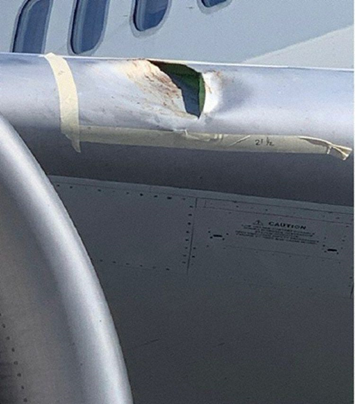
(Photo taken from Avherald.com) - 21 May – Seattle (WA)
United A320, was climbing through 2000 feet in night time conditions when the crew declared emergency reporting they had just hit something, subsequently reporting they had a bird strike at the left hand side. The aircraft landed back about 13 minutes after departure;
https://www.kiro7.com/news/local/plane-returns-to-sea-tac-after-bird-strike/951382865 - 22 May – Brownsville (TX)
World Atlantic Airways MD83, bird strike during the initial climb; landed back 35’ later; - 25 May – London (Stansted)
Easyjet A319, during the initial climb an engine ingested a bird. In the absence of abnormal indications the crew continued the climb but eventually decided to land back about 50’ after takeoff. - 25 May – Tel Aviv
LOT B737, on approach the aircraft received a bird strike. The aircraft was unable to depart for the return flight due to problems with the flaps, the return flight was cancelled. - 31 May – Philadelphia (PA)
American A330, rejected takeoff at low speed (about 60 knots) reporting a small bird in the nose gear. Flight delayed. - 1 June – Unknown location
Thomas Cook A321, suffered a bird strike that did not allow the aircraft to fly the next leg: a charter flight for supporters of a football team going to play the Champions League final
https://www.dailymail.co.uk/sport/sportsnews/article-7094077/Hundreds-Tottenham-fans-559-Thomas-Cook-charter-flight-delayed-Stansted.html - 3 June – New York (La Guardia)
American ERJ190, during the initial climb out the crew reported a bird strike and requested a precautionary return about 15’ after take off;
https://pittsburgh.cbslocal.com/video/4097322-plane-en-route-to-pittsburgh-strikes-bird-returns-to-laguardia-airport/ - 5 June – Graz
Corendon B737, was accelerating for takeoff when the left hand engine ingested a bird. The crew continued takeoff but returned for landing about 9 minutes after departure. Video available in the link below.
https://www.airlive.net/incident-corendon-airlines-airbus-a320-experienced-birdstrike-into-the-left-engine-during-rotation-at-graz-airport-video/ - 10 June – Genoa
Alitalia A319, during the take-off run an engine ingested a gull; the crew rejected take-off at high speed; flight cancelled;
https://telenord.it/birdstrike-allaeroporto-di-genova-gabbiano-nel-motore-volo-per-roma-inchioda-sulla-pista/ - 11 June – Alghero
Corendon Dutch B737, during the initial climb the aircraft flew through a flock of seagulls and a bird impacted the nose of the aircraft. The crew landed back about 30 minutes after departure. The aircraft was unable to depart again due to the bent nose. The flight as well as the next leg were cancelled. - 12 June – Constanta
Wizzair UK A321, on final the left engine ingested a bird; the aircraft was unable to perform the next leg; - 12 June – Riga
Air Baltic B737, during the initial climb the right hand engine ingested a bird causing strange noises and subsequent vibrations. The crew did not identify the causes and decided to land back; they first performed a low approach to have the landing gear checked from the ground; finally the passengers were instructed to brace for landing, and the aircraft landed about 100 minutes after departure. - 13 June – Kochi
Air India Express B737, during the initial climb a bird impacted the aircraft prompting the crew to land back about 35 minutes after departure; the aircraft needed to be replaced. - 15 June – Philadelphia (PA)
American B767, on final approach a bird impacted and penetrated the leading edge of the left hand wing;
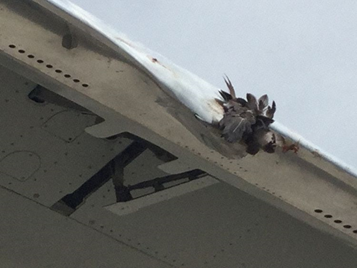
(Photo taken from Avherald.com) - 15 June – Montreal
Commutair ERJ145, during the initial climb the left engine ingested a bird; the crew declared Mayday and landed back 10’ later; - 18 June – Boston (MA)
American ERJ190, suffered a bird strike on rotation with a fairly large bird; the crew didn't know about any damage, however, as a precaution they left the flaps and slats in position. The aircraft landed back about 15 minutes after departure. The flight was cancelled.
https://www.youtube.com/watch?v=V3FdCu6jp6Y
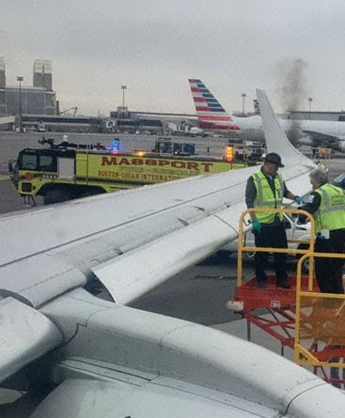
(The left hand slat just outboard of the engine dented by the bird strike; photo: Gavin Baker taken from Avherald.com) - 20 June – Edimburgh
TUI Airways B737, bird strike during the initial climb; the crew decided to divert to Glasgow;
https://www.thescottishsun.co.uk/news/4388505/edinburgh-lanzarote-flight-bird-strike-divert-glasgow/ - 22 June – Malta
Air Malta A320, bird strike on approach; the aircraft was unable to continue its schedule;
https://www.newsbook.com.mt/artikli/2019/06/22/air-malta-flight-delayed-due-to-birdstrike/?lang=en - 23 June – Calgary
WestJet B737,during the initial climb a bird hit the windshield, making visibility difficult; the crew decided to return circling to burn fuel and landed 90 later;
https://www.cbc.ca/news/canada/calgary/westjet-flight-bird-strike-1.5186987 - 25 June – Multan (Pakistan)
Flydubai B737, during the approach an engine ingested a bird; the aircraft was unable to perform the return flight; - 25 June – Raleigh/Durham (NC)
Southwest B737, on final at about 2000 ft. flew through a flock of Turkey Vultures (Cathartes aura) receiving damage; - 26 June – Sofia
El Al B737, during the initial climb an engine ingested a bird that caused the presence of fumes in the cabin; the crew decided to make a precautionary landing back;
A few months ago we announced the release of the investigation report on this accident, published ten years after the event, postponing our comments to the next update of this website.
A careful reading of the report highlighted some aspects that seem having been neglected, especially as for recommendations are regarded. These in fact represent the proactive part of any investigation, which, as it is common knowledge, tend exclusively to ascertain the causes in order to prevent future accidents. While in this case the causes appear to be sufficiently clear, however, there is a lack of some recommendations that we have tried instead to emphasize in order to change the unfortunately still widespread opinion that sees bird strikes as an inevitable and unpredictable natural event.
On the contrary, although their total elimination is impossible, they are a phenomenon that can be foreseen and contained within acceptable margins of risk.
Our comments on the report can be read here.
The 2017 BSCI annual report is finally available on the ENAC institutional website.
The reason for the delay in publication seems to be the complex bureaucratic procedure for appointing an external wildlife consultant expert. However, the fact that the Italian Civil Aviation Authority does not have an own in-house permanent team of wildlife experts is pretty unusual.
That said, in 2017 we can see with pleasure a decrease in the total number of impacts, which we hope will represent a permanent trend. However, it is always necessary to point out, as indeed BSCI also does, that statistical fluctuations may depend on various factors and it is early to shout for victory.
As usual, we try to offer our contribution to the deepening of the question with some observations and comments on the report.
This extraordinary photo shows the effects of a bird ingestion into a USAF C17 engine. The photo was taken during the recent Australian Air Show held in Avalon (Victoria) from 1 to 3 March.
The video that appears by clicking on the link below shows an event (not rare) of a multiple bird strike with gulls. The event occurred in Barcelona on 5.5.2018. The most impressive thing is the number of birds that fall on the runway after the impact despite their attempt to avoid the collision with a giant landing at 250 km/h with the engines at idle. The disconcerting thing, however, is that there is no trace of this event even on the most documented sources on this matter.
This leads to reflect on the statistics reliability and on the fact, complained also by ICAO, that 70% of the strikes are unreported.
The Australian Transport Safety Bureau (ATSB) has published the statistics on wildlife strikes during the 2008-2017 period. https://www.atsb.gov.au/media/5775747/ar-2018-035_final.pdf
The report shows that over the ten-year reporting period, there have been 11 occurrences involving one or more birds ingested into two engines of turbofan-powered aircraft. Only one of them however regarded a four-engine aircraft.
India's DGCA released their final report on the incident occurred to a GoAir A320. During the take-off run, a bird struck the right hand engine causing vibrations and abnormal sounds. The crew continued take-off, shut the left hand engine down and decided to land back. The crew subsequently recognized they had shut the wrong engine down, restarted the left hand engine and reduced the right hand engine to idle. The aircraft landed back about 20 minutes after departure.
Also in this quarter there was a considerable number of cases (at least five) in which the crew, after having suffered a bird strike of which presumably did not know entity and damages, consciously decided to continue the flight. Reasonably, the pilots had to take into account the risks related to the duration of the flight, the presence of alternate airports along the route, etc., but the fact that such flights in most cases ended with a landing back or a diversion, is quite perplexing. Furthermore, in some cases post-flight inspections revealed substantial damages that prevented the continuation of the flight, or worse, determined an engine replacement. The airlines do not issue precise directives for these cases and consequently very often the crews are left on their own to decide what to do. A clear position would therefore be desirable in this sense, obviously prudential and conservative, from the airlines.
- 5 January – Tokyo
ANA A321, during the initial climb an engine ingested a bird but recovered; the crew continued the flight to destination. The aircraft was unable to depart for the return flight however as the spinner was found missing from the engine after arrival. - 6 January – Sao Paulo (Brazil)
TAAG Angolan Airlines, B777, on approach an engine ingested a bird and failed. The crew managed to land normally. The aircraft was unable to depart for the return flight, however. - 10 January – Auckland
Cathay Pacific B777, during the initial climb the aircraft flew through a flock of birds and received a number of bird strikes. In the absence of abnormal indications, the crew continued the flight but then decided to return to Auckland bout 90’ after departure after having dumped fuel.

(The dent on the radome as result of the bird strike; photo obias taken from Avherald.com) - 11 January – Spokane (WA)
United A320, during the initial climb the aircraft flew through a flock of geese; a bird impacted the windshield of the aircraft leaving it covered with blood. The crew, also considering the weather and visibility at Spokane, decided to divert to Seattle. - 21 January – Tampa (FL)
American Airlines A321, during the initial climb at about 400 ft. one or more birds impacted the right wing causing damage; the crew decided to land back immediately about 25’ after the departure.
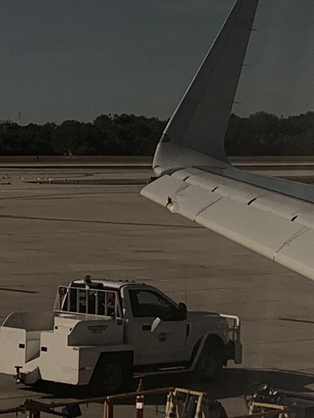
(The right wing; photo by Chad Carroll taken from Avherald.com) - 22 January – Peshawar
Pakistan International Airlines B777, during the initial climb a bird impacted the radome causing a dent; in the absence of abnormal indication the crew decided to continue the flight to destination (Jeddah). After having reached FL380 and being enroute about 160nm southwest of Peshawar the crew turned to divert to Karachi due to a higher fuel burn than anticipated.
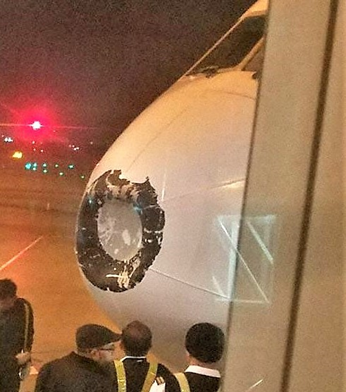
(Photo taken from Avherald.com) - 26 January - near Rio de Janeiro
LATAM Chile B767, bird strike on take-off; the crew continued the climb to initial cruise level 330 in absence of abnormal indications. After levelling off indications for an engine prompted the crew to shut the engine down. The aircraft dumped fuel and landed back about 105 minutes after departure. - 31 January – Panama City
COPA Airlines B737, during the initial climb the right engine ingested a bird causing the engine to repeatedly surge. The crew landed back about 15 minutes after departure.

(Photo taken from Avherald.com) - 3 February – Geneva, United B767
rejected takeoff at high speed (about 130 knots over ground) following a bird strike into one of the engines. Two flights were instructed to go around as result of the rejected take-off. The flight was cancelled. - 7 February – London (Heathrow)
Air India B787, during the approach a windshield cracked reportedly due to a bird strike; - 10 February – Dubai
Flydubai B737, during the initial climb the crew reported that an engine had ingested a bird, however, the engines were fine. A short time later the crew told the engines were still fine, but cabin crew reported smoke in the cabin, Immediate landing back about 15’ after departure
https://www.arabianindustry.com/supply-chain/news/2019/feb/11/saudi-bound-flydubai-plane-declares-emergency-after-birdstrike-in-dubai-6037850 - 14 February – Toronto
Air Canada Rouge B767, during the take-off run the crew observed a bird, felt an impact and a yaw, however, engine parameters remained normal. The crew continued take-off and then decided to continue the flight as all indications were still normal. Enroute at FL330 the crew received indications of increasing vibrations of the left hand engine and decided to return to Toronto.
Maintenance decided to replace the left engine. Remains of a bird of prey were found on the runway. - 24 February– Kalibo (Philippines)
Cebu Pacific ATR72, rejected take off following a bird strike;
https://www.sunstar.com.ph/article/1794182 - 26 February – Kasane (Botswana)
South Africa Airlink ERJ135, climbing through 7000 feet at about 240 KIAS a large bird, reportedly a vulture, impacted the aircraft's nose, penetrated the pressure vessel and became stuck.
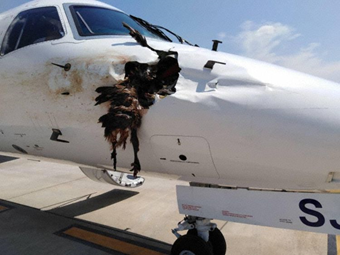
(Photo taken from Avherald.com) - 27 February – Lexington (KY)
Expressjet CRJ200, bird strike on approach;

(Photo by Jay Brown taken from Avherald.com) - 5 March, Beirut (or Abu Dhabi)
MEA A320, after the landing at Abu Dhabi a post flight inspection revealed evidence of a bird strike into an engine; the aircraft was unable to depart for the return flight on schedule.
http://www.dailystar.com.lb/News/Lebanon-News/2019/Mar-07/478201-mea-civil-aviation-dispute-bird-strike-location-beirut-or-not-beirut.ashx - 6 March – Munich
Lufthansa A321, during the take off the Tower observed smoke from the aircraft and something falling off the aircraft. A runway inspection found debris on the runway, small pieces of bird(s) possibly originally being a larger bird. The crew was informed and decided to land back about 25 minutes after departure. A postflight inspection revealed the right hand engine had ingested a number of birds. - 7 March - Brasilia, LATAM A320
during the initial climb the left engine ingested several birds prompting the crew to land back about 25’ after departure. - 14 March – Austin (TX)
Delta A319, on approach hit a bird that caused minor damages to the leading edge of the right wing. - 14 March – Rio de Janeiro
Emirates B777, on approach a bird impacted the aircraft. The aircraft was unable to continue its schedule, the onward legs as well as the return legs needed to be cancelled. - 16 March – Vancouver
United A320, immediately after take-off flew through a flock of ducks and received multiple bird strikes. The crew decided to land back about 20 minutes after departure.
The runway was closed for about 15 minutes for clean-up. A number of ducks hat hit the left side of the fuselage and caused damage to 5 low pressure compressor blades of the left hand engine, blade tip curl and blade tips missing. The blade damage warranted an engine replacement. - 19 March – Boston (MA)
Jetblue ERJ190, in the initial climb the crew advised they had hit a bird and needed to return as a precaution.
https://www.bostonherald.com/2019/03/19/suspected-bird-strike-forces-jetblue-flight-to-return-to-logan-airport/ - 19 March – Aberdeen
Loganair Saab 340, shortly after take off was forced to land back due to a bird strike;
https://www.shetlandtimes.co.uk/2019/03/19/bird-strike-forces-sumburgh-flight-to-return-to-aberdeen - 21 March – Houston
Southwest B737, on short final at 200 ft. the crew reported they had flown through a flock of small birds; unknown damage. - 22 March – Lahore
PIA B777, on approach a bird impacted and penetrated the leading edge of the left hand wing; however was unable to depart for the return flight on schedule.

- 26 March – Kansas City (MO)
Endeavor Air CRJ 900, bird strike during the approach at about 4000 ft. - 28 March – Ottawa
Air Canada A321, during the approach flew through a flock of birds and some of them were ingested in the left engine that suffered damages; the crew declared emergency and landed with only one engine;
https://www.ctvnews.ca/canada/hairy-landing-for-air-canada-passengers-after-bird-strikes-engine-1.4356476 - 28 March – Washington (DC)
United B777, during the initial climb the crew reported they just had "a fairly large birdstrike at the nose". The crew dumped fuel and returned about 55 minutes after departure. Maintenance assessed the damage to the nose finding the damage to have remained within the limits permitted and released the aircraft to depart again.

(The traces of the bird strike; photo taken from Avherald.com) - 29 March – Corvera (Spain)
Ryanair B737, during the initial climb an engine ingested a bird; the crew decided to divert to Alicante; - 30 March – Vagar (Faroe Islands)
Atlantic Airways A319, during the initial climb an engine ingested a bird; the crew landed back 21’ after take off; the engine needed to be replaced; - 30 March – Belem (Brasile)
Azhul Linhas Aereas A320, rejected take-off at high speed following a bird ingestion into one engine; flight cancelled;
https://www.youtube.com/watch?time_continue=56&v=2hZ30UjLjkY - 31 March – Boston (MA)
American Airlines ERJ190, bird str;ike during the initial climb; the crew decided to land back 10’ later;
https://boston.cbslocal.com/2019/03/31/boston-logan-airport-new-york-bound-flight-returns-bird-strike - 31 March – Munich
Easyjet A320, bird strike at rotation; landed back 25’ after take-off; - 31 March – Shanghai
Spring Airlines A320, rejected take off following a bird strike; the aircraft was unable to continue its flight;
